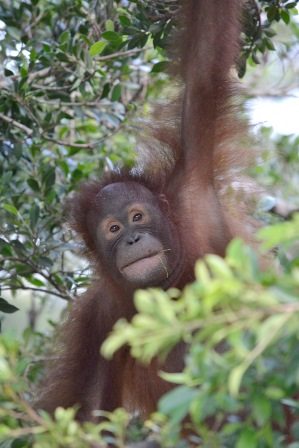As we’re asking you to Go Orange for Orangutans this October, you may wish to polish up on your orangutan facts so you can share with family, friends and colleagues what you know about these amazing animals.

They may also come in handy when you’re asking people to buy a piece of cake you’ve baked to raise money for Go Orange, or when you’re collecting your sponsor money for dying your hair orange!
Basics
Orangutans are the only genus of apes alive in Asia today and are the only existent species in the subfamily Ponginae.
There are two species of orangutan: Bornean and Sumatran. The Bornean orangutans are split into 3 subspecies:
- Northwest Bornean orangutan
- Central Bornean orangutan
- Northeast Bornean orangutan
Orangutans can live for 30 years and females can grow up to 127cm in height and 45.4kg in weight and they have a 9 month gestation period. Infants are dependant for two years and are weaned at 4. By the time they are 6-8 years old they then move away from their mothers.
Male orangutans can grow up to 175cm in height and 118kg in height, with an arm span of 2m! The males do not care for young and between 15-20 years they develop cheek flanges, throat pouches and long hair. There are different mating strategies for flanged and un-flanged males.
Tool Use
There are 54 types of tool use in wild orangutans which include:
- Extract insects or honey
- Opening or preparing fruit
- Napkins
- Gloves
- Cushions
- Poultice for wounds
- Clean teeth
- Swatting insects
Food
Orangutans are opportunistic foragers and eat mainly fruit, however there are 317 types of food that they do eat, including:
- Fungus
- Insects
- Honey
- Leaves
- Bark
- Flowers
- Pith
Other
The largest known species of ape is related to orangutans – this was the Gigantopithecus which could grow up to 3m tall!